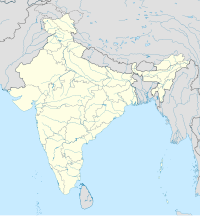Achabal Gardens, "the places of the princes", is a small Mughal garden located at the southeastern end of the Kashmir Valley in the town of Achabal, Anantnag district, India. The town is located near the Himalayan Mountains.[1]
 View of Achabal Gardens | |
| Location | Achabal, Anantnag district, India |
|---|---|
| Region | Asia |
| Coordinates | 33°40′59″N 75°13′20″E / 33.6831°N 75.2222°E |
| Type | Mughal Gardens |
| Length | 142 metres (466 ft) |
| Width | 14 metres (46 ft) |
| Area | 1,952.4 square metres (21,015 sq ft) |
| History | |
| Builder | Nur Jahan |
| Founded | 1620 A.D. |
| Cultures | Mughal Empire |
| Site notes | |
| Condition | Rebuilt |
| Public access | Public garden |
Background
editThe garden was built around 1620 A.D. by Mughal Empire Emperor Jahangir's wife, Nur Jahan. It was remodeled by Jahanara, who was the daughter of Shah Jahan around 1634-1640 A.D. The garden was rebuilt, following decay, on a smaller scale by Gulab Singh and it is now a public garden.[1] A main feature of the garden is a waterfall that enters into a pool of water.[2]
This place is also noted for its spring, which is said to be the re-appearance of a portion of the river Bringhi, whose waters suddenly disappear through a large fissure underneath a hill at the village Wani Divalgam in the Brang Pargana. It is said that in order to test this, a quantity of chaff was thrown in the Bringhi river at a place its water disappears at Wani Divalgam and that chaff came out of the Achabal spring. The water of the spring issues from several places near the foot of a low spur which is densely covered with deodar trees and at one place it gushes out from an oblique fissure large enough to admit a man's body and forms a volume some 46 centimetres (18 in) high and about 30 centimetres (12 in) in diameter.[3]
Gallery
editReferences
edit- ^ a b Achabal Gardens. Archived 23 December 2012 at the Wayback Machine Archnet.org. Retrieved 2012-01-17.
- ^ Achabal Gardens. GardenVisit. 2008. Retrieved 2012-01-17.
- ^ Koul, Pandit Anand: Archaeological Remains in Kashmir page 94. Mercantile press, 1935.
Further reading
edit- Brookes, John. (1987). Gardens of Paradise: History and Design of the Great Islamic Gardens. London: Weidenfeld & Nicolson.
- Crowe, Sylvia; Haywood, S.; Jellicoe, S.; Patterson, G. (1972). The Gardens of Mughal India. London: Thames and Hudson.
- Petruccioli, Attilio. "Gardens and Religious Topography in Kashmir." Environmental Design. 1-2 (1991):64-73.

